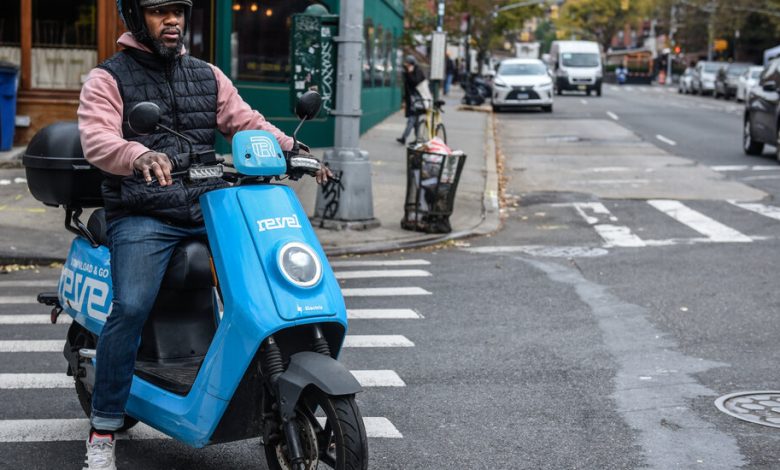Why Revel Shut Down Its Moped Service in New York

When Revel brought 68 electric mopeds to a Brooklyn storefront in 2018, it set out to show New Yorkers that getting around the city could be fun.
Riders could hop onto an electric-blue moped instead of cramming into the subway or getting stuck in car traffic. At its height, Revel’s ridership neared 600,000 rides in a single month. It seemed like a glimpse of the city’s future.
“I was taking buses and subways all my life, but when this came around, I was like ‘This is great, this is cool, this is accessible,’” said Donald Reid, 43, a podcaster in Brooklyn who became a regular rider.
But now, five years later, the mopeds will soon disappear entirely. What happened?
On Saturday, Revel — facing the proliferation of other options to get around the city and safety concerns that have kept some people away — will pull its mopeds out of New York and send them to a salvage center. It will also shut down the moped service in San Francisco after previously ending it in other cities.
“It’s the appropriate time,” Frank Reig, Revel’s chief executive, said in an interview last week, citing ridership declines combined with the company’s shift in recent years to building an all-electric fleet of more than 500 ride-share cars and four charging hubs.
Revel’s mopeds have lost ground to e-bikes and other cheaper and more convenient options in an increasingly competitive environment, said Bruce Schaller, a consultant and former city transportation official who has studied various forms of micromobility for more than a decade.
“You have this crowded marketplace — a lot of offerings, a lot of choice — and I’m hard put to think of why you would prefer a Revel over an e-bike today,” he said.
But back when Revel launched, competitors were less plentiful. The moped-sharing service quickly expanded in New York and spread to five other cities, including San Francisco and Washington. It drew a loyal following and helped fill transit gaps particularly in Brooklyn and Queens, where it was a quick way to move around and between the two boroughs. Revel’s monthly ridership soared to a high of 582,159 rides in July 2020.
Since then, Revel has struggled to attract — and hold onto — riders as Citi Bike, the city’s popular bike-share program, steadily expanded its e-bike fleet and many New Yorkers bought their own e-bikes and e-scooters, and in some cases, illegal mopeds.
Revel’s moped ridership in New York fell to 136,802 rides in July, a 30 percent drop from 194,278 rides in July 2022.
Revel also faced multiple lawsuits filed by riders who said the mopeds malfunctioned and others who said they had been injured by Revel riders.
There have been five deaths involving Revel mopeds — four were Revel riders and one was a pedestrian struck by a Revel rider — between 2019 and 2021, according to city records.
Mr. Reig said the company’s focus on electric ride-share cars and charging hubs evolved from its moped service: the challenge of charging thousands of moped batteries “opened up our eyes to some other very large problems when it comes to urban environments and charging infrastructure.”
Some transportation experts said that the end of the moped service was a setback to efforts to encourage alternatives to car use. But, they added, it is hardly surprising given that policies governing everything from roads to tax incentives largely favor electric cars over other mobility options.
“All the incentives are encouraging operators to do what they’ve done: to move to cars, to focus on cars,” said Rachel Weinberger, the director of research strategy at the Regional Plan Association, a planning group focused on the New York metropolitan area, adding that Revel’s shift to electric cars “should be a wake-up call” for the government to do more to encourage other options.
The idea for the moped service was inspired by Mr. Reig’s 2017 vacation in Buenos Aires, which he discovered was a “moped town.”
Mr. Reig, a former consultant who worked with investors in the energy and real estate industries, returned home and recruited a colleague, Paul Suhey, to start Revel. They raised $1 million from investors and rolled out in Bushwick, Williamsburg and Greenpoint.
By 2020, Revel was operating a fleet of more than 3,500 mopeds in Brooklyn, Queens, Manhattan and the Bronx. The average moped ride was 26 minutes and covered 3.4 miles.
“I have a fun time driving it,” said Tejas Vemparala, 31, a data analyst at the Brooklyn Navy Yard, before riding off on a moped to get lunch last week. “You get to enjoy the nice weather.”
But problems arose. Revel briefly suspended its moped service in July 2020 after two fatal crashes, including one that killed Nina Kapur, a television journalist. E-bikes and e-scooters have also raised their own safety concerns. And the lithium-ion batteries that power e-mobility vehicles and devices have become a leading cause of fire deaths.
Mr. Reig said Revel had implemented “enhanced safety protocols,” including requiring riders to pass an online safety test and take a photograph of themselves wearing a helmet, which is stored under the moped seat.
City officials also tightened regulation of the moped service, noting that after the fall of 2021, there were no more fatalities.
Still, some New Yorkers stayed away from the mopeds. “I don’t think they’re safe,” said Nicole Halsey, 45, who rides Citi Bikes. “You’re riding in New York City traffic. If you lose control, what do you do?”
City officials and Lyft, which operates Citi Bike, have unveiled plans to more than double the current e-bike fleet of 8,500 by the end of 2024. Citi Bike set a record in August with more than 4 million monthly rides.
Mr. Schaller compared the costs to riders of taking Citi Bike and Revel and found that Citi Bike was the better deal. A 20-minute trip would cost $4.67 for a typical rider with a Citi Bike membership on an electric Citi Bike, or about one-third the $13.50 cost of the same trip on a Revel moped.
“It was hard for Revel to find a niche when you have far cheaper competition that’s for a very similar service,” he said.
Mr. Reig said that Revel’s pricing reflected the higher costs of operating mopeds versus e-bikes, including carrying liability insurance for riders.
Revel riders were also required to have a valid driver’s license — which ruled out many city residents. And they could not ride in bike lanes or on major bridges, including the East River crossings linking Manhattan with Brooklyn and Queens, and had to find on-street parking.
Mr. Reid, the Revel rider in Brooklyn, said that while he enjoyed taking out the mopeds, he used Citi Bike a lot more often, because it was cheaper and more convenient and he could ride the e-bikes over the bridges to Manhattan.
Still, Mr. Reid said that he liked having both options — and would miss the mopeds.
“It’s sad to see it go away,” he said. “You can just jump on and roll out.”




